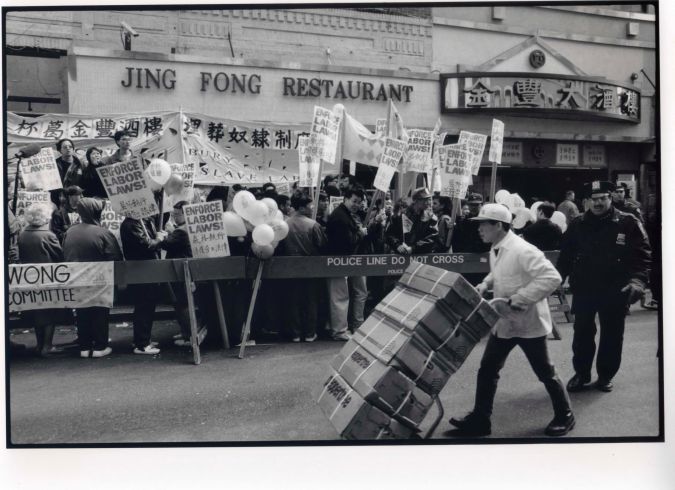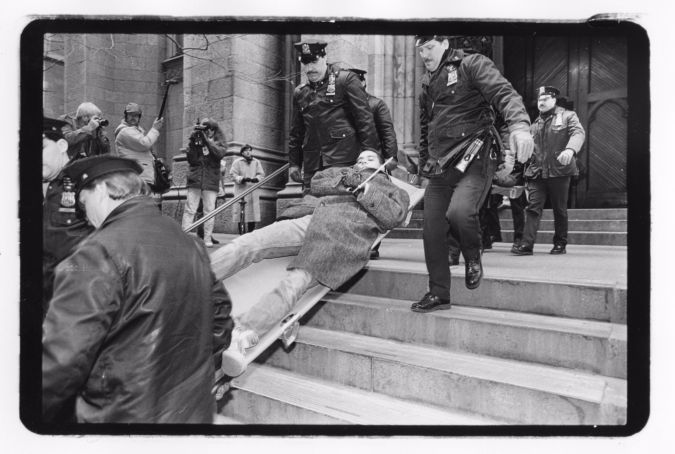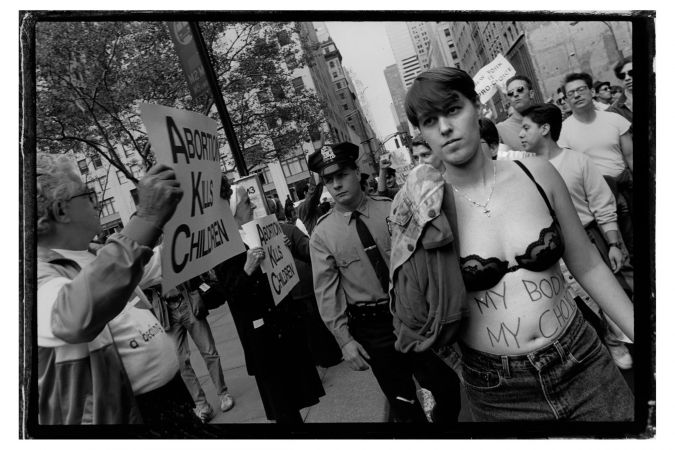How exactly should one photograph a political demonstration? There are a few schools of thought, I imagine, and it may be helpful to think of these approaches in similar terms to those used to discuss the various approaches to literary translation – both translators and photographers work across languages in order to best make a work intelligible to different audiences. In the case of the photographer, the translation occurs across mediums instead of languages. The political photographer must take an act of public theater (protests don't just employ the theater as a means of advancing political programs; protests are themselves a type of performance), and turn the transitory into the concrete, that is, into an object that may be reproduced, disseminated, and dissected. In other words, the photographer must translate the protest into an image in order to make it intelligible to those who were not present.
So what are the possible approaches? First, there is the idea that a photograph of a political demonstration should convey the protestors' message as accurately and as faithfully as possible. The viewer of such a photograph should be able to glean the mission, context, and content of the protest with relative ease – photography as mission statement.
The second approach would be to capture the "feeling" of the moment or the text. The photograph may be devoid of orienting context, and the viewer may be unsure what exactly is being protested, but the feeling of the moment may be effectively communicated – and through this emotional content, the viewer will have understood something essential about the specific moment and about protest in general. Photographs like these can therefore be abstracted and used for myriad purposes – thus speaking to their aesthetic merits, but perhaps dulling their impact as tools for a specific cause.
Finally, a political photograph may fall into some middle ground between the other two approaches– it will preserve the emotional immediacy of the moment as it was lived while simultaneously supplying enough context for the viewer to ground the image in relation to a specific issue. All three approaches are represented by the photographs at "Whose Streets? Our Streets!" an exhibition of New York protest photography between 1980 and 2000 which recently opened at the Bronx Documentary Center (full disclosure – I currently write for Reading the Pictures, which is edited by Meg Handler, one of the curators of the exhibition).
Because I attended the exhibition on opening night, my viewing experience was slightly different than the average viewer's is likely to be. The exhibition took place in a small room that was made even smaller by the booth serving food and beer, the table where prints and books were sold, and a hanging piece displaying newspaper and magazine covers by the north wall. The room was packed with people (many of the photographers whose photos were on display were also present). I arrived about an hour after the official opening, and by the time I had made my way over to the west wall of the exhibition, the display most heavily saturated with photographs, all of the accompanying informational sheets had been taken. I was therefore left to my own devices when it came to figuring out what the photographs were trying to depict.
The absence of context however only enhanced my experience of the exhibition and I would recommend that everyone look at the photographs unguided before turning to the informational sheets. Viewing in this way forces you to focus on the aesthetic value of the photographs while simultaneously considering just what it is you are looking at – coming into the viewing experience with prior information can put the primacy on the message instead of the medium (if you attend the exhibition on a night when they have run out of informational sheets, there is an incredibly comprehensive website that provides context and insight into the photographs on display). And many of these photographs, in addition to forcefully putting forward a political statement, are also incredible in terms of their composition, poise and execution.
Consider this image by Corky Lee:

© Corky Lee
Because we read text from left to right, we also tend to read images in the same way – the left is the "beginning" of the image, so to speak (the reverse pattern holds true for people who read languages that are written from right to left). At the "beginning" of Lee's picture, we see a cluster of protestors holding signs that say "ENFORCE LABOR LAWS" against a backdrop of Chinese lettering. The first connotation for a western viewer is likely a sweatshop, but as we continue tracking left, we see that the protestors are outside of the Jing Fong Restaurant. We can also finally see the text of the large banner behind the protestors – "SLAVE" followed by "LAB" from which we can extrapolate the phrase "SLAVE LABOR." So far we have been tracking the middle ground and background of the "first" 2/3 of the image, but as we enter the last third, our focus shifts to the foreground where we see a man in a white coat pushing five boxes on a trolley. It is sa fe to assume that he is a worker for the Jing Fong Restaurant. The image of the laborer against the backdrop of a labor protest informs what we would usually consider to be a mundane action in a sinister light – this is no longer just "labor" this is "exploited labor" or, as the banner suggests "slave labor." The message is further driven home by the rightmost element of the photograph, the police officer. In reality, the officer was likely there simply to keep order, but in the context of the narrative of the photograph, the tone of which has been set by the protestors, the officer looks less like a keeper of the peace than an enforcer, an overseer, following behind the laborer to ensure that he continues his work.
Lee's photograph is both an aesthetic and political success. The compositional technique of the photograph gives the viewer a narrative lens through which to interpret the events, and that narrative lens is certainly sympathetic to the protestor's cause. The effect, both artistically and politically (the two cannot really be separated here), is immediate. The photograph follows our third approach to translation.
Other images in the exhibition fall into the two other approaches (this is not a value judgment – simply a manner of grouping). This image by Brian Palmer of a young man on a stretcher being taken down the steps of a Church by the police can serve as an example of a photograph that is immediately emotionally effective, but disorienting in terms of political content.

© Brian Palmer
We are immediately drawn to the man on the stretcher in the center of the photograph. Is he wounded? Is he dead? If so, how? Why is he being carried by the police and not an ambulance crew? Without context, it appears as if some kind of violent crime has occurred in the Church and this man is either its victim or its perpetrator (which may explain the police). The image of a wounded man on a Church's steps, arms seemingly crossed in repose, flirts with the iconography of religious funerals, and evokes feelings of reverence, pity and indignation. He seems somehow holy, while the police presence (the police as a representation of the state monopoly on the legal use of violence) at a site of worship and "peace" is somehow a desecration, hence the indignation.
In reality, however, the man on the stretcher is not wounded – he is a protestor from ACT UP, an AIDS activism group. The man was arrested during the "Stop the Church" action – a protest against St. Patrick's Cathedral in response to Cardinal John O'Connor's anti-gay, anti-condom, anti-sexual education comments. Once we know the context for the photograph, the zip tie on the man's wrists comes into focus, and the man on the stretcher becomes the invasive presence, not the police. Without the context, the man on the stretcher draws the sympathy of the viewer. Of course, he continues to do so within the context as well, but to a more conservative minded viewer, the image seen without context, then with, might inspire some conflicting feelings – the religious super-ego shutting down the prior emotional response.
As an example of the literal, we can look to this photograph by Sandra Lee Phipps:

© Sandra Lee Phillips
Here we see a woman with "MY BODY MY CHOICE" written on her stomach, flanked by protestors wielding "ABORTION KILLS CHILDREN" signs. The narrative content of the photograph is clear – here we have a pro-choice protest with an anti-abortion (anti-choice) counter-protest. We immediately know the message. The photograph still, is incredibly well composed. The pro-choice protesting woman is surrounded on all sides, on the left by the anti-abortion rally, on the right, by a group of men (who seem to be a part of the pro-choice rally, but their status is ambiguous), and behind, by a police officer, that is, by the state. The image is claustrophobic, and the woman's isolation offers an "us against the world" story, but because the immediate circumstances of the photograph are readily apparent, it is unlikely to cause any manner of emotional-ideological cross-firing as in the case of the Palmer photograph – which makes it perhaps more effective as a pro-choice statemen t.
The exhibition features an enormous wealth of material, representing a number of issues with images that are by turns intimate and explosive. In a brief speech given halfway through the exhibition, curator Meg Handler said that when she and co-curator Tamar Carroll conceived the exhibition they anticipated that they would be "celebrating the victory of the first female president," not nervously awaiting the inauguration of Donald Trump. But in light of Trump's election, the timing of the exhibition could not be better. Not only can it serve as an inspiration for future protests, but it can also give us a refresher course on how to effectively document those protests. And, insofar as a protest seeks to be more than locally effective, documentation is what truly makes the action.
Jake Romm is the Forward's culture intern. Contact him at romm@forward.com or on Twitter, @JakeRomm
Source: On The Eve Of Trump's Inauguration, This Exhibition Of Protest Photography Is As Fresh As Ever
No comments:
Post a Comment